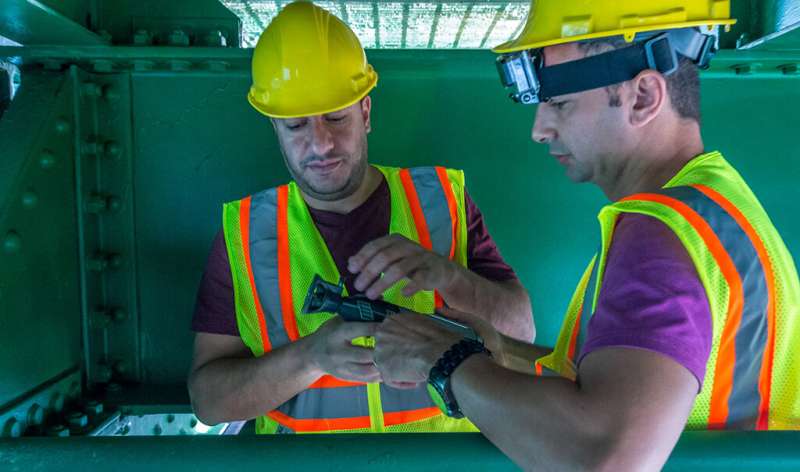MSU has developed sensors that can detect road wear, bridge defects and more. Some sensors have already been deployed to Michigan's iconic Mackinac Bridge. Credit: MSU
The first 20 prototype infrastructure sensors installed in 2016 on the Mackinac Bridge, powered solely by vibrations from traffic, have proven their durability and performed as intended. Now researchers from Michigan State University and Washington University in St. Louis are ready to roll out the next phase of testing, installing up to 2,000 of the tiny devices to explore the logistics of a large-scale deployment and provide useful monitoring data to the Mackinac Bridge Authority.
"The successful large-scale deployment of this novel low-cost sensing technology will dramatically transform the economics of bridge preservation/management and ultimately improve the serviceability of bridges," said Nizar Lajnef, MSU associate professor of civil and environmental engineering. "We also will explore how the collected data could be used for improved cost-effective, condition-based maintenance of the Mackinac Bridge structural components. We are excited that this will be the first fully instrumented bridge in the country using advanced wireless and self-powered monitoring technology."
Beginning in 2016, Lajnef and Shantanu Chakrabartty, WUSTL professor, started deploying prototype sensors beneath the bridge as part of a demonstration project sponsored by the Federal Highway Administration. The Mackinac Bridge provided a high-profile testing ground for these self-powered sensors. Since then, the new and improved versions of the self-powered sensors have been developed as a part of the National Science Foundation's Cyber-physical Systems program and have been successfully deployed on the bridge.
Several of the sensors' features make them attractive to infrastructure managers. Because the sensors have no external power source, they eliminate the issue of requiring battery changes or wiring to power sources. They also don't need wires to access the data they collect; staff can access the information wirelessly.
"In addition to being a statewide need, the development of effective methods for preserving our transportation infrastructure systems is a critical national need," Lajnef said. "Through this large-scale deployment, we would show that the system can autonomously monitor the loading experienced by the bridge components, and that the information from the sensors can be collected without significant human intervention and at significantly low cost."
MSU is an ideal partner in advances such as these due to the university's commitment to test emerging technologies for new mobility solutions. As part of this initiative, the university is well equipped to advance mobility by leveraging its expertise and collaborating with strong industry partners.
MBA staff will assist with installation of the additional sensors, offering equipment and access to the bridge. MBA will retain ownership of the data gathered by the sensors, with WUSTL providing the sensor prototypes and MSU providing tools to analyze and interpret that data for bridge staff to use in guiding engineering and maintenance decisions. The team can use the data for research publication with approval from MBA.
The team plans to start installation of the additional and improved sensors this summer. The researchers will coordinate installation timing and any necessary lane closures with MBA staff.
Provided by Michigan State University























